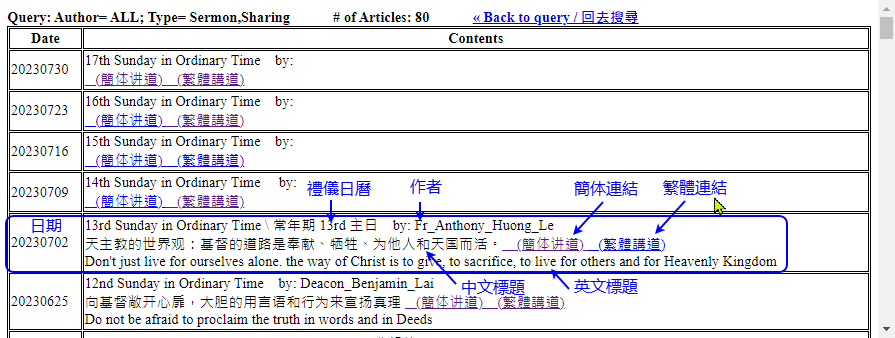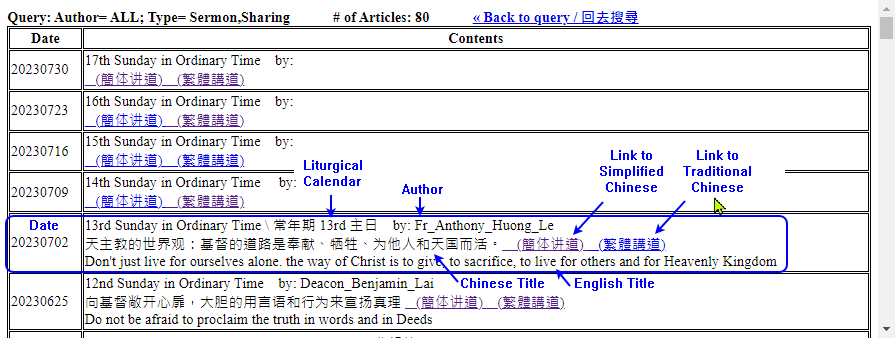中文指引 or Help in English
« Back to query / 回去搜尋;
如何搜尋:
搜尋文章的 4 種方法:
#1:選擇作者; #2:選擇 '講道' 和/或 '分享';
#3: 選擇日期; #4: 選擇禮儀日曆名稱。
如果單擊  時尚未指定任何搜尋內容,那麼所有文章都會被選
時尚未指定任何搜尋內容,那麼所有文章都會被選

搜尋結果:
假設今天是20230705,而下面這個報告是搜尋的結果
在報告的頂部,列出了所有的搜尋參數、被選文章的總數以及返回 '如何搜尋' 的鏈接。
接下來是從最新日期開始的被選文章摘要。讓我們看看 20230702 的講道。這是 20230705 之前的最後一次講道

第一列 '日期' 是發布的日期 - 20230702。
第二列 '內容' 有 3 行。
第一行是禮儀曆上的日期名稱。
第二行是中文主題,接著有 2 個翻譯的鏈接。 點擊鏈接來看翻譯
第三行是英文主題。
對於 20230709 以及已後的日期,都沒有作者。 這些日期都還沒有到所以沒有講道。 如果您點擊任何翻譯鏈接,它指向該日的聖經閱讀,以便您閱讀並反思,為彌撒做準備。
Define query:
4 ways to select articles:
#1: Select Author; #2: Select 'Sermon' and/or 'Sharing';
#3: Select publication date; #4: Select Liturgical Calendar name.
If you click  without specifying anything, the default output is all articles.
without specifying anything, the default output is all articles.

Query Report:
Suppose today is 20230705 and the following is the Query Report.
At the top of the report, it lists the query parameters, # of Articles, and a link to go back to the query.
Followed by a summary report of selected articles starting with the latest date.
Let's look at the row consisting of the sermon of 20230702. This is the last sermon before 20230705

The first column is the date of publication - 20230702.
The 2nd column of 'Contents' has 3 lines.
The 1st line is the name of the date on the Liturgical calendar.
The 2nd line is the topic of the article in Chinese followed by links to 2 translations. You may click at the link to see the corresponding translation
The 3rd line is the topic in English.
For the dates of 20230709 and beyond, none of them has an author. These are the future dates and the sermons are not yet delivered. If you click any of the translation links, it points to the Bible reading of that date so that you may read and reflect on them to prepare for the Mass.
« Back to query / 回去搜尋;
 時尚未指定任何搜尋內容,那麼所有文章都會被選
時尚未指定任何搜尋內容,那麼所有文章都會被選 

 without specifying anything, the default output is all articles.
without specifying anything, the default output is all articles.
